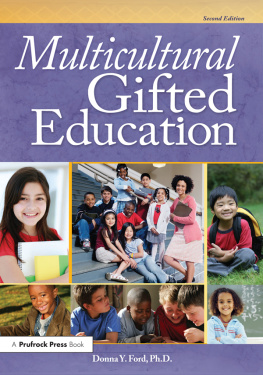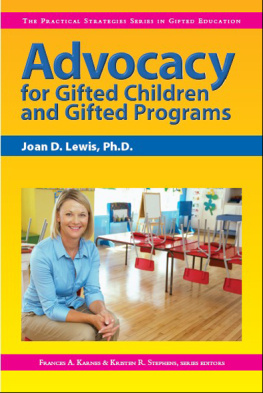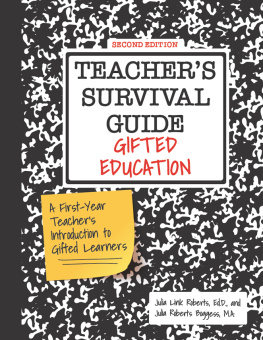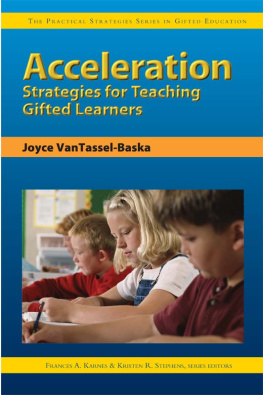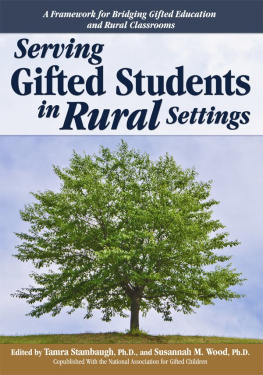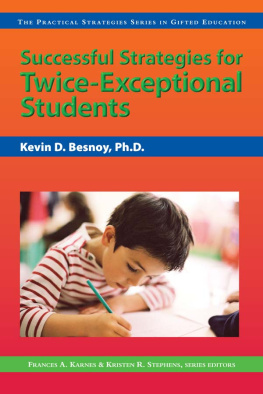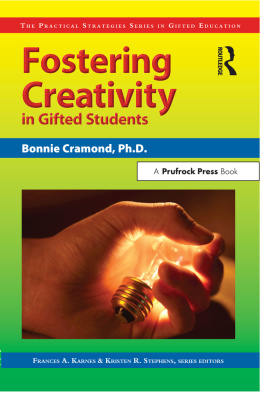Thank you to Thomas Godfrey for his assistance in all phases of assembling this volume. The sample rows from parallel menu activities for typical and gifted students developed by Stacey Gibbs were used with permission. Her willingness to share her work with others is gratefully appreciated.
Introduction
Providing a high standard of education for our rural as well as urban students has been this countrys intent, but often we have failed to achieve this goal. A number of factors have made guaranteeing educational equality for all students, regardless of location, more of a work-in-progress than a reality. The reasons for the failure of our resolve have been well documented, but increasingly evidence has accumulated that favors rural classroom innovations as opportunities for achieving educational success, despite apparent obstacles.
Awareness of rural educations ingenuity in accomplishing much with very little budgetary support for curricular improvement has begun to take root in the educational community. There are important reasons for this new focus on rural education. More than 40% of all American schools are in rural areas and 30% of all students attend rural schools (National Research Center on Rural Education Support [NRCRES], 2005, para. 2). The poorest rural populations are in the poorest states [which are] least able to afford the cost of an adequate education (Johnson & Strange, 2007, p. vi). These statistics highlight the need for paying attention to rural education. The links between low incomes and poverty, reduced level of education, and small towns/rural areas are even greater for families of minority groups (Colangelo, Assouline, & New, 1999). Even though states with the highest percentage of culturally diverse students must provide for the highest percentage of public elementary students taking advantage of the federally funded free and reduced lunch program (Colangelo et al., 1999, p. 44), some modest redirection of state resources could incentivize teaching innovation in and outside classrooms.
Rural education has gained respectful attention for a variety of reasons, despite the absence of uniform funding-allocation formulas among state legislatures. School enrollments have increased substantially in communities of 2,500 and under while larger communities have witnessed a decrease in students (Johnson & Strange, 2007). In fact, the 12 most populous states account for almost 50% of rural enrollees. The nation has denied proportionate financial support to small-town education in favor of urban or large suburban communities. Inequities of salary and benefits in smaller districts are slowly being addressed, but disparities still exist, especially in high-poverty regions (Johnson & Strange, 2007). As rural America grows increasingly [culturally] diverse, the need for adequate resources and supportive policy environments to meet the needs of English Language Learner (ELL) students grows even more important (Johnson & Strange, 2007, p. vi). More help nationally is being siphoned from rural use to the growing number of non-English-speaking young immigrants, due to their need to be assimilated culturally and vocationally.
Other obstacles need to be overcome. Student drop-out rates remain high in many cities and small towns alike. In rural areas, school consolidation continues to crowd single-building schools that often are the pride and social centers of small communities. The consolidation of schools continues despite research that concludes small schools serve their enrollees better than mergersas verified by improved graduation rates, attendance, and achievement levels (Johnson & Strange, 2007).
Given these realities, it is only natural to ask how best to maintain a quality educational program in remote areas where funding is limited by lower population numbers, and recruiting experienced teachers (especially ones with specialized training) is problematic. Can resources be found to establish high-quality programs that meet the needs of all students, particularly high achievers? The content of this book aims to address these questions affirmatively and to identify and examine the components of a workable, successful collaboration among school administrators, teachers, students, parents, and other supporters from the community. The idea is to accomplish together what cannot be done separately.
Defining Rural
Just what constitutes rural is difficult to define and is becoming increasingly more complicated as the demographics of America evolve. Arnold, Biscoe, Farmer, Robertson, and Shapley (2007) have attempted to systematize the growing diversity by dispensing with terminology that seems vague. For years, even the federal governments many definitions of rural were inconsistent and frequently of little use, such as not metropolitan. Arnold et al. describe six major categories of federal definitions (see Table 1); all have been used in some way to better understand the challenges facing rural schools (p. iii), including those with reference to population density, geographic features, and levels of economic and industrial development (p. iii). Clearly defining what rural means has tangible implications for public policies and practices in education, from establishing resource needs to achieving the goals of No Child Left Behind in rural areas (Arnold et al., 2007, p. iii).




